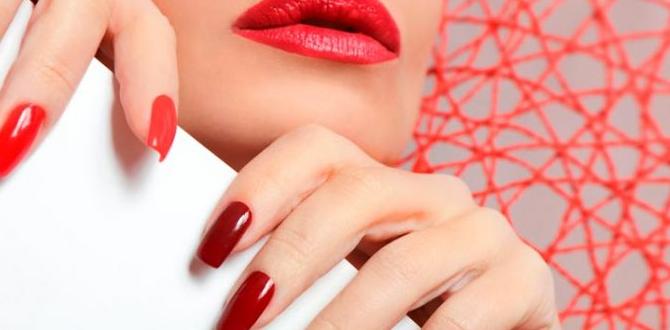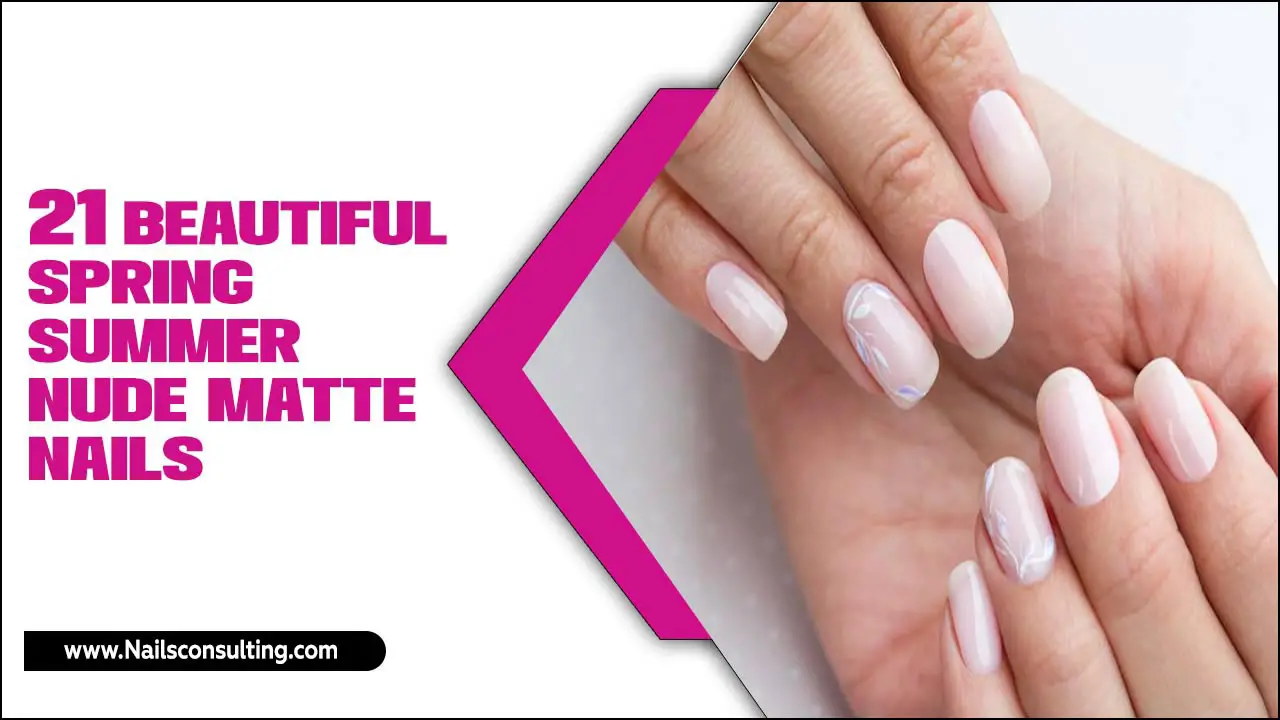Matte nail designs are a chic and modern way to elevate your manicure. This tutorial breaks down how to achieve stunning matte nails at home with essential tips for a perfect, chip-resistant finish, from choosing the right polish to mastering application techniques and exploring design ideas.
Dreaming of that velvety soft finish on your nails? Matte nails have taken the beauty world by storm, offering a sophisticated and edgy alternative to the classic glossy look. But getting that perfect, non-shiny finish can sometimes feel a little tricky. You might end up with streaky nails, a chalky texture, or a design that just doesn’t hold up. Don’t worry! Achieving salon-worthy matte nails at home is totally doable, even if you’re just starting out. We’re going to walk through everything you need to know, step-by-step. Get ready to transform your nails into a work of art!
Why Embrace the Matte Manicure?
Matte nail designs offer a unique aesthetic that’s both understated and eye-catching. Unlike glossy finishes, matte nails have a subtle, velvety texture that absorbs light, creating a soft, sophisticated look. This makes them incredibly versatile, pairing beautifully with everything from casual everyday wear to elegant evening attire. Plus, they’re a fantastic canvas for creative nail art!
The Allure of the Surface
The primary appeal of matte nails lies in their distinct texture. They provide a modern twist on traditional manicures, offering a depth and richness that gloss simply can’t replicate. This finish can make bold colors appear more intense and subtle shades feel more luxurious. It’s a way to express your style with a clean, contemporary edge.
Versatility for Every Occasion
From a deep, matte burgundy for a formal event to a soft, matte pastel for a brunch date, matte nails fit seamlessly into any scenario. They’re less prone to showing minor imperfections like nicks and scratches that can be more obvious on a high-gloss surface. This durability, combined with their chic appearance, makes them a practical choice for busy individuals who still want to look polished.
Essential Tools for Your Matte Manicure
Before we dive into creating those gorgeous matte designs, let’s gather your toolkit. Having the right supplies makes all the difference in achieving a professional-looking finish. You don’t need a lot of fancy equipment; most of these items are staples for any nail enthusiast.
The Must-Haves:
- Base Coat: Crucial for protecting your natural nails and ensuring a smooth canvas for your polish.
- Matte Top Coat: This is your secret weapon! It transforms any regular nail polish into a matte finish.
- Nail Polish Colors: Choose your favorite shades! Darker colors tend to look particularly striking in a matte finish.
- Nail File and Buffer Block: For shaping your nails and creating a smooth nail surface.
- Cuticle Pusher/Orange Stick: To gently push back your cuticles for a clean nail bed.
- Rubbing Alcohol or Nail Polish Remover: For cleaning and prepping your nails.
- Lint-free Wipes: Essential for removing dust and oils without leaving fuzz behind.
- Optional for Designs: Thin nail art brushes, dotting tools, striping tape, stencils, glitter, or contrasting glossy polishes.
Getting Started: Prepping Your Nails for Perfection
Just like any great masterpiece, a stunning nail design starts with a flawless base. Proper nail preparation is key to a long-lasting and beautiful matte manicure. Skipping these steps can lead to chipping, peeling, and an uneven finish. Let’s get those nails ready!
Step-by-Step Nail Prep:
- Remove Old Polish: Make sure all traces of previous nail polish are completely gone. Use a good quality nail polish remover and lint-free wipes.
- Shape Your Nails: Gently file your nails to your desired shape. Always file in one direction to prevent splitting and weakening. A standard nail filing technique ensures a smooth edge.
- Buff the Surface: Use a fine-grit buffer block to gently buff the surface of each nail. This removes any ridges and creates a smooth, even surface for polish to adhere to. Be gentle; you’re not trying to thin your nails!
- Cleanse Your Nails: Wipe each nail thoroughly with rubbing alcohol or nail polish remover on a lint-free wipe. This removes natural oils and any dust or residue from filing and buffing. This step is critical for polish adhesion.
- Hydrate Cuticles (Optional but Recommended): Apply a cuticle oil or hand cream to moisturize your cuticles. You can do this after you’ve finished your manicure as well, but a little hydration beforehand can make them look neater. Just be sure to wipe away any excess oil from the nail plate before polish application.
The Magic of the Matte Top Coat: Application Techniques
The secret to achieving a perfect matte finish lies in the matte top coat. It’s a special formulation that dries to a non-shiny, velvety texture. But how you apply it can make a world of difference!
Applying Your Matte Top Coat:
- Apply Your Color: Apply your chosen nail polish color(s) as you normally would. You typically need two thin coats for full opacity. Allow each coat to dry completely before applying the next. Rushing this step is a common mistake!
- Ensure Color is DRY: This is vital! Your colored polish must be completely dry to the touch before you apply the matte top coat. If you apply it too soon, you’ll likely smudge the color or create an uneven finish. You can test by gently tapping two nails together; if they stick, they’re not ready. A good rule of thumb is to wait at least 5-10 minutes after your last color coat.
- Apply the Matte Top Coat: Now for the magic! Apply a thin, even layer of your matte top coat. Work quickly but carefully. Avoid going over the same spot multiple times, as this can also lead to streakiness.
- Cap the Free Edge: For extra durability and to prevent tip-chipping, “cap” the free edge of your nail. This means running the brush lightly along the very tip of your nail from top to bottom.
- Let it Dry: Allow the matte top coat to dry completely. This usually takes about the same amount of time as a regular top coat, but always check the product instructions. Resist the urge to touch your nails before they are fully dry!
Common Pitfalls and How to Avoid Them:
- Streakiness: This often happens when the matte top coat is applied unevenly or too thickly. Ensure your colored polish is thoroughly dry, and apply the matte top coat in thin, fluid strokes.
- Chalky Appearance: Some lower-quality matte top coats can look a bit chalky. Investing in a good brand can make a significant difference. Also, make sure your nails are perfectly clean and oil-free before application.
- Smudging: This is almost always due to applying the matte top coat over wet color polish. Patience is key here!
- Loss of Matte Finish: Over time, some matte finishes can develop a slight sheen. Reapplying a thin layer of matte top coat every few days can help maintain the velvety look.
Matte Nail Design Ideas for Every Skill Level
Now for the fun part! Matte nails are a fantastic base for all sorts of designs. Whether you’re a complete beginner or looking to try something more intricate, here are some ideas to get your creativity flowing.
Beginner-Friendly Matte Designs:
These are simple, impactful designs that require minimal special techniques.
- The Classic Matte: Simply apply your favorite color and finish it with the matte top coat. Effortlessly chic!
- Matte with a Glossy Tip: Apply your matte color, then use a fine brush and a regular glossy top coat to paint just the tips of your nails like a French manicure. The contrast in finishes is fabulous.
- Matte with a Single Glitter Accent Nail: Paint all nails matte, then apply a glitter polish to your ring finger and seal with a regular top coat over the glitter for shine and protection.
- Two-Tone Matte: Use tape or stencils to create simple geometric shapes (like a half-moon or a diagonal split) and paint each section with a different matte color.
Intermediate Matte Designs:
These designs might involve a bit more precision or layering.
- Matte Ombre: Create a gradient effect using two complementary matte colors. You can achieve this with a makeup sponge or by carefully blending with a brush. Seal the entire nail with a matte top coat.
- Matte French Mani with a Twist: Instead of white tips, use a contrasting matte color, or even a metallic shade.
- Matte Nails with Glossy Details: Paint your nails in a solid matte color, then use a thin brush and glossy top coat to add small dots, stripes, or even delicate outlines.
- Matte with Stamped Designs: If you have a stamping plate and stamper, you can stamp designs onto your matte nails using regular polish. Once dry, seal with a matte top coat.
Advanced Matte Designs:
For those who love a challenge and have a steady hand!
- Matte & Glossy Texture Play: Combine matte bases with glossy accents in intricate patterns. Think matte black with glossy abstract lines or floral elements.
- Matte with Hand-Painted Art: If you’re artistic, hand-paint small designs like flowers, abstract shapes, or even tiny characters onto your matte base. Use regular polish and then apply a matte top coat over the entire nail, being careful not to dull fine details too much.
- Matte With Foil Accents: Apply matte polish, then use a nail foil adhesive and transfer foils to create metallic or holographic pops of shine against the matte backdrop.
A Table of Top Coat Options
Not all matte top coats are created equal. Here’s a quick look at some popular types and what to expect:
| Type of Matte Top Coat | Pros | Cons | Best For |
|---|---|---|---|
| Standard Matte Top Coat | Widely available, effective at creating a matte finish. | Can sometimes be streaky if not applied correctly; quality varies by brand. | Everyday matte manicures, beginners. |
| Quick-Dry Matte Top Coat | Dries very quickly, reducing smudge risk. | May have a more intense matte finish that could appear slightly chalky to some. | Those short on time; preventing smudges. |
| Gel Matte Top Coat | Requires a UV/LED lamp to cure; provides excellent durability and a long-lasting matte finish. | Requires a UV/LED lamp and gel polish; removal process is more involved. | Long-lasting manicures, professional-looking finish. |
| Matte Top Coat with Glitter/Shimmer | Adds a subtle (or not-so-subtle) hint of sparkle to the matte finish. | The matte effect might be slightly less pronounced due to the added particles. | Adding texture and interest to plain matte colors. |
Using Your Matte Top Coat Effectively
To get the best results from any matte top coat, remember these golden rules: keep your strokes smooth and consistent, avoid over-brushing, and ensure your base color is bone dry. A good matte top coat should transform your polish without altering the color significantly.
Maintaining Your Matte Manicure
Matte manicures are gorgeous, but they can sometimes be a bit more delicate than their glossy counterparts. With a little care, you can extend the life of your beautiful matte finish.
Tips for Longevity:
- Be Gentle: Avoid using your nails as tools. Opening cans, scraping surfaces, and rough handling can lead to chipping, even with a good top coat.
- Moisturize: Keep your hands and cuticles moisturized with cuticle oil and hand cream. Dryness can affect the appearance and durability of your manicure. Apply oil around the cuticles and sides of the nails, avoiding the main nail surface where polish is applied.
- Wear Gloves: When doing chores that involve water or chemicals (like washing dishes or cleaning), wear rubber gloves. This is one of the best ways to protect any manicure.
- Reapply Top Coat (If Needed): If you notice the matte finish starting to dull or regain a slight sheen after a few days, you can carefully apply another thin layer of your matte top coat to refresh it.
- Avoid Harsh Chemicals: Prolonged exposure to certain chemicals, like those found in cleaning products or even some hand sanitizers, can break down the polish.
Matte vs. Glossy: A Quick Comparison
Understanding the difference between matte and glossy finishes helps in choosing the right look and application for different occasions and design types.
| Feature | Matte Finish | Glossy Finish |
|---|---|---|
| Appearance | Velvety, light-absorbing, soft, sophisticated. | Shiny, light-reflecting, vibrant, classic. |
| Texture | Smooth, non-shiny. | Smooth, reflective. |
| Durability | Can be slightly more prone to showing wear or developing a sheen over time; requires careful application and maintenance. | Generally very durable; shows smudges and chips more readily due to reflectivity. |
| Design Versatility | Excellent for creating contrast with glossy elements, modern looks, and sophisticated color depth. | Classic for French tips, vibrant colors, and designs where shine is desired. |
| Application Challenge | Requires precise application of matte top coat; especially sensitive to dry time of base color. | Can be more forgiving during application; some top coats offer UV protection to prevent yellowing. |
Choosing between matte and glossy often depends on the overall vibe you’re going for. Matte can feel more contemporary and understated, while glossy is timeless and bold. Many nail artists love to combine both finishes in a single design for maximum impact!
Frequently Asked Questions About Matte Nails
Q1: Can I make any nail polish matte without a special top coat?
A1: Not entirely. While some DIY methods (like using cornstarch/baking soda with polish) occasionally pop up, they’re unreliable, can damage your nails, and don’t offer a durable, smooth finish. The best and safest way is to use a dedicated matte top coat. These are specifically formulated to provide that velvety texture.
Q2: How long do matte nails usually last?
A2: Typically, a well-applied matte manicure can last anywhere from 5 to 10 days, similar to a glossy manicure. However, they might be slightly more susceptible to developing a sheen or showing wear if not cared for properly. Proper prep and a good quality matte top coat are key!
Q3: Is it hard to do matte nail designs at home?
A3: Not at all! Simple matte designs, like a solid matte color or a matte French tip, are very beginner-friendly. More intricate designs might take practice, but you can start with easy techniques and build your skills. Don’t be afraid to experiment!
Q4: Can I use a matte top coat over nail stickers or decals?
A4: Yes, you can! Apply your nail stickers or decals to your dried polish, and then carefully apply a thin layer of matte top coat over the entire nail to seal them and give them a uniform matte finish. Be gentle so you don’t lift the sticker.
Q5: My matte nails look streaky. What did I do wrong?
A5: Streaky matte nails are usually caused by applying the matte top coat too thickly, unevenly, or over polish that wasn’t completely dry. Make sure your color coats are fully dry before applying the matte top coat, and try to apply the top coat in thin, fluid strokes. You might also try a different brand of matte top coat, as quality can vary.
Q6: Can I put a regular (glossy) top coat over a matte nail?
A6: Absolutely! This is a popular technique for creating contrast. You can paint your nails with a matte top coat and then use a glossy top coat to add details like dots, stripes, or a shiny French tip. Just be sure the matte layer is completely dry first.
Conclusion
Matte nail designs offer a beautiful, modern aesthetic that’s surprisingly approachable for DIY enthusiasts. By focusing on proper nail preparation, understanding the magic of a good matte top coat, and practicing a few simple application techniques, you can achieve flawless, velvety nails right at home. Whether you opt for a single, chic matte shade or venture into creative designs using contrasting finishes, matte nails are a fantastic way to express your personal style. Don’t be afraid to experiment with different colors, textures, and simple design elements. With these essential tips, you’re well on your way to mastering the matte manicure and impressing yourself (and everyone else!) with your gorgeous, sophisticated nail art. Happy polishing!




